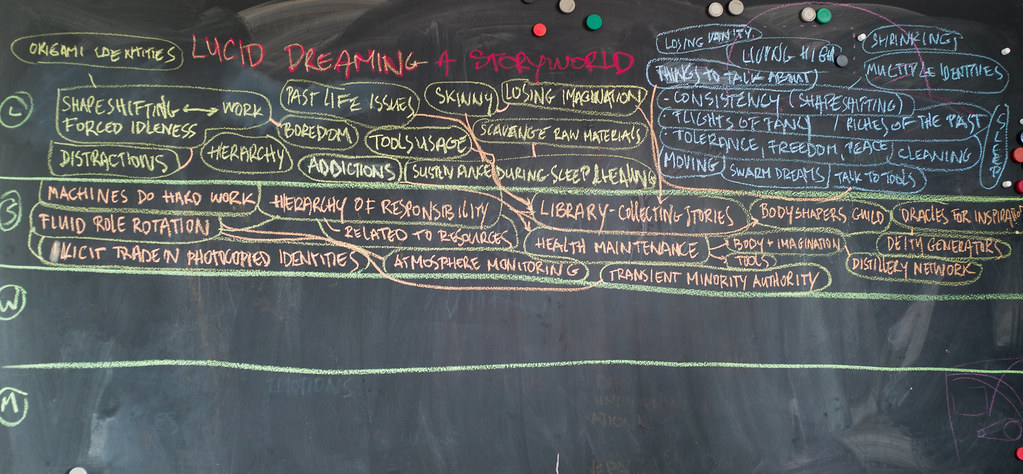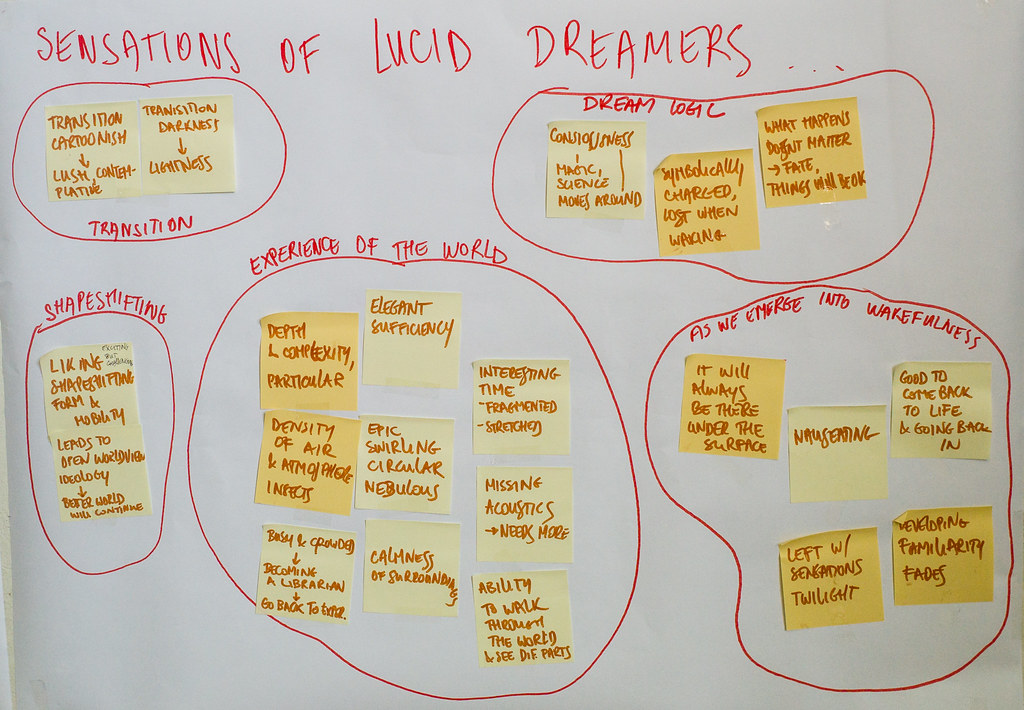Future Fabulators
Table of Contents
Scenario Building As Lucid Dreaming
Note: These are facilitators' notes in progress for the Lucid dreaming a storyworld workshop, held by FoAM at Time's Up in Linz in June 2014. The notes still need much cleaning up. If you'd like to try the process yourself and something is unclear, send us an email at bxl [at] fo [dot] am
Day 1
Framing
11:00 - 11:10 framing: brief, lucid dreaming, scenario processes, instructions for participants (see lucid dreaming a storyworld)
Broadening awareness
11:10 - 11:20 meditative, focusing exercise - sensory-scan
- broadening awareness the beam of a flash-light: breath → body → room → hearing → seeing → thoughts & feelings → 360 degrees.
What's in the box?
Exercise for becoming aware of 'dreams' (or uncontrolled streams of (un)consciousness, and letting them flow, observing what happens
11:20 - 11:40 what’s in the box?
- the facilitator explains the improvisation. Something along the lines of “I will give each of you a box. in the box is a gift, the gift you always wanted to receive. enjoy the gift for a few moments, then start walking in the space, changing directions when you feel like it. Keep the box for a while, then swap the box with someone else. Let go of its contents and focus on the process of giving a gift to someone. The receiver accepts the box and again receives a perfect gift (the contents of the box change through the process of 'giving'). keep passing the boxes around, giving and receiving. Please do so in silence. At some point I will ask you to open the box and tell me what is in it. Please answer without thinking - what comes up is the best thing it could have. Any questions?”
- When the questions have been answered, the facilitator asks everyone to stand in a circle and experience the sensations of standing still and noticing what thoughts and feelings emerge in their minds.
- One by one, the facilitator gives the participants a 'box' by holding a box-like space in between his/her hands (different sizes for different people).
- The facilitator observes what happens and subtly supports the participants if s/he sees they are blocked or uncomfortable (give them another box, suggests they lift it above their heads to feel the weight, shake it, put their hands in it…)
- After some minutes, the facilitator pulls one participant from the group and asks: “can you open the box please? what’s in the box? Put your hand in a bit deeper… is there anything else else is in the box? How about if you shake it? Did anything come loose? And if you smell it?” The facilitator notes down the contents of the box, thanks the participants and invites them to sit on the perimeter and observe the others. One by one all the participants should have a chance to discover what is in their boxes.
- Once everyone has spoken and is sitting down, the exercise is over.
- The facilitator reads the list of contents from everyone's boxes
- If appropriate a reflection on the exercise can happen now, otherwise move to the next stage.
+++ notebook, pen +++

Known
11:40 - 11:50 what do we know ?
- facilitator writes down things 'found in boxes' on a larger piece of paper
- short discussion about the 'known' elements of the world. are there any links, can some of them be merged
- time allowing (not in our exercise at TU), you might want to make a map/affinity diagram of the world using only the known elements
+++ large piece of paper, marker, KPU template +++
Presumed
11:50 - 12:10 what can we presume?
- free association (brainstorming) - based on the known elements, what can we safely assume about this world?
- structured conversation (in a circle, with a 'speaking ball' - when you get the ball, speak then throw it to someone you want to hear from)
+++ ball, large piece of paper, marker, KPU template +++
Unknown
12:10 - 12:25 what is unknown?
- Look at your hands, feet, legs, etc. Are they the usual shape? Do you have the right amount of digits? Is any part of your body disfigured?
- when you dream, sometimes your body has a different shape. take on a dreamlike shape and put yourself in that positing for a while, then look at what is known and presumed. spend a few moments in silence in this position and keep asking yourself - what do i not know, but would like to know?
- come back to normal position and say what is unknown to you about this world at present
- facilitator adds the “unknown” column to the known and presumed
+++ large piece of paper, marker, KPU template +++

Visible aspects
12:25 - 12:45 what does the world look like (focus on visible, physical characteristics)?
- free (automatic) writing for 2-3 minutes, then 2-3 minutes pull out characteristics individually, share them with the group (post-its), create a clustered map (or just a list if no time is available)
+++ A4 paper, pens, large piece of paper, post-its +++
Inhabitants
12:45 - 13:05 who are the inhabitants in this world? what are they like? what do the inhabitants do? what tools do the inhabitants use? where are you in this world?
- exquisite corpse using these questions. one question per person. fold, continue.
+++ 8 A4 papers, pens +++
13:30 - 14:00 collect and summarise answers to questions: who are the inhabitants in this world? what are they like? what do the inhabitants do? what tools do the inhabitants use? where are you in this world?
- go through each question, collect answers from all exquisite corpses
- write answers on a piece of paper
+++ large piece of paper, markers +++

lunch
Dreams and problems
15:10 - 15:30 what are the inhabitants’ problems and what their dreams?
- each participants takes one of the 'exquisite corpse' inhabitant descriptions, imagines what they might be like, what their dreams and problems might be
- share problems and dreams with the group, facilitator summarises on the blackboard
- (this was planned, but due to an unexpected schedule shortening, was not executed: each person takes one character, reflects on the character for a couple of minutes, tries to move into the character, embody it… conversations in pairs, role-play each of the characters as if they just saw each other on the train platform. you know that you have a deep sense that you know them, but don’t remember who they are. they start talking to you about their deepest problems and their dreams - don’t think, just see what comes out. report the other character’s dreams and problems.)
+++ blackboard, chalk +++
Systems and forces
15:30 - 16:00 what forces influence the inhabitants’ dreams and problems? larger systems?
- look at the clouds of dreams and problems, then free associate - which institutions or other social systems might be behind the problems, or could realise people’s dreams? what are the drivers of change in this world?
- facilitator interjects with lucid dreaming questions (Are you able to shift objects across a room or area without going near them?), connects/re-incorporates things from previous exercises)
+++ blackboard, chalk +++

Day 2
Sinking in
09:30 - 09:50 transporting back into the world
- make yourself comfortable, close your eyes, focus on breath,
- thich nhat hahn's meditation breath-grass-mountain-lake-space
- visualisation of the world (facilitator reads out the description)
- look around - what can you smell, touch, hear, see, taste?
- come back, open your eyes
Living in the world
09:50 - 10:10 what is the inhabitants’ relationship with their environment?
- Look at the ground underneath your feet. Does it look normal or not?
Free association
- what is the environment like in the world? what about the climate? weather?
- what is the geography like?
- how are the inhabitants relating to their environment? are they in balance with it it, seeing it as a source, a threat, wilderness?
+++ big paper, marker - add to what is the world like? +++
Worldviews
10:10 - 10:40 what ideologies and values do you see emerging? are there different civilisations or other groups? how do the inhabitants relate to each other?
- each person writes down one or more groups, civilisations+ideologies on post-its.
- facilitator takes the post-its, then interviews the group with 5 whys.
- write names of groups, civilisations and ideologies on blackboard
Free association
- how do different groups/civilisations/ideologies relate to each other?
- how do they relate to the environment and world as a whole?
+++ post-its, pens, blackboard, chalk +++
Stories
11:50 - 12:50 what is/are the myth(s) on which the (different) culture(s) developed? how do the (different) inhabitants feel about their world?
- split in 2 groups (pick a piece of paper from a hat, there are papers with squares and circles
- each group comes up with a sketch for a story about the world, as headlines from the newspapers
- present newspapers to the whole group
- facilitator summarises the overarching stories
+++ a4 papers, markers, post-its, blackboard, chalk +++

—- break
A day in the life
13:00 - 13:30 a day in the life of…
- split in 3 groups
- pick one of the inhabitants
- describe a day in the life of this inhabitant. what do they do, who do they encounter, how do they feel, what do they wear, eat, where do they live, work… (20 mins)
- share the stories
- facilitator summarises (on A4 pieces of paper)

Participant journey
13:30 - 13:45 a lucid dream / participant journey
(the other parts took a longer time than planned, so this part has been shortened
- each participants writes down how they might experience the world in a lucid dream (20 minutes). use words, images, drawings…
- everyone shares their experiences of the world
- facilitator summarises (on A4 pieces of paper))
- spend a few minutes contemplating all the aspects of the world
- if you were a lucid dreamer - what would you do in this world?

13:45 - 14:00 what is the name of the world?
- look at the different stories and feelings about the world, together the ideologies, systems, dreams and problems,
- collectively find a name for this world, and/or a slogan that summarises it
+++ blackboard, chalk, CLA template +++
lunch: concluding discussions and suggestions for next steps.
15:00 - 17:00 doing nothing with Theater Nix
